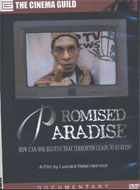
Promised Paradise: How Can One Believe that Terrorism Leads to Heaven? 2006
Distributed by Cinema Guild, 115 West 30th Street, Suite 800, New York, NY 10001; 212-685-6242
Produced by Leonard Retel Helmrich
Director n/a
DVD, color, 52 min.
Jr. High - Adult
Anthropology, Sociology, Indonesia
Date Entered: 12/18/2008
Reviewed by Christopher Lewis, American University Library, American UniversityThe title of this documentary is misleading. It gives the impression the viewer will learn something about what motivates some Muslims to become terrorists, a subject that has been addressed more than a few times on video. However the video is less about that than it is a character study of Indonesian puppeteer/troubador Agus Nur Amal.
The video begins with Amal doing a sing-song stage production to children about the destruction of the World Trade Centers and the ensuing hapless search for Osama Bin Laden. The audience’s laughter suggests this is a twisted bit of brainwashing, imprinting U.S.-bashing in young impressionable minds, however that’s not the intent. When the show turns to the terrorist bombings in Bali, the audience goes silent.
Amal, a Muslim, acts genuinely confused why fellow Indonesian Muslims could believe it was god’s will to kill other people, especially other Muslims. A portion of the video follows him as he seeks to understand how such acts could be justified in some people’s minds. His child-like behavior comes across as more surreal than earnest though. He travels from Jakarta to Bali and gains an audience with Imam Samudra, one of the jailed planners of the Sari Club bombing. Samudra’s simplistic rationale for killing others to serve the prophet leaves Amal unconvinced and he later meets with a paranormal adviser to try to learn of the disposition of the suicide bombers from where they reside in the afterlife.
What’s most interesting about the film is its snapshot of Indonesian life where folk traditions such as puppet shows, troubadors, and paranormal advisors don’t seem to be considered unusual. In addition to Amal and the paranormal advisor the other principal subject is Endang, a “vagabond” friend of Amal, who does little more than hang around the streets and get harassed by others.
The film has no narration and doesn’t have much of a thesis though it is often fascinating to watch. This should be considered an optional selection for public and academic libraries. It’s probably better suited to anthropology classes than international studies or peace and conflict resolution programs.